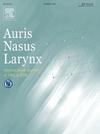The efficacy of early voice therapy in patients with vocal fold paralysis after thyroidectomy
IF 1.5
4区 医学
Q2 OTORHINOLARYNGOLOGY
引用次数: 0
Abstract
Objective
The therapeutic effects of voice therapy, including relaxation exercises, semi-occluded vocal tract training, and vocal function strengthening exercises, have been studied in patients with vocal fold paralysis following thyroid surgery. However, optimal timing for initiating voice therapy remains unclear. This study aims to evaluate the effects and patient satisfaction associated with early voice therapy initiated within one month post-thyroidectomy in patients with unilateral vocal fold paralysis.
Methods
A retrospective review was conducted on 63 patients diagnosed with unilateral vocal fold paralysis after thyroidectomy. Thirty-two patients received early voice therapy within one month post-surgery (average of 3.5 sessions), while 31 patients did not receive any therapy. Comprehensive voice assessments, including laryngeal videostroboscopy, auditory-perceptual, acoustic, and aerodynamic evaluations, were performed preoperatively and at 2 weeks, 2 months, 6 months and 1 year post-surgery. Subjective voice satisfaction was assessed using the Thyroidectomy-related Voice and Symptom Questionnaire.
Results
Preoperative analyses revealed a no significant differences between the two groups in most of the key voice outcomes, including the TVSQ.Voice therapy led to significant improvements in high pitch range (p=0.021), maximum phonation time (MPT) (p=0.006), and perceptual voice quality, and a reduction in throat discomfort. Furthermore, this group demonstrated a faster recovery to preoperative voice levels, in contrast to the non-therapy group, which experienced slower and incomplete recovery.
Conclusions
Early voice therapy following thyroidectomy is effective in enhancing vocal outcomes for patients with unilateral vocal fold paralysis, facilitating faster recovery and improved long-term voice function through enhanced glottic closure and pitch control.
早期语音治疗对甲状腺切除术后声带麻痹的疗效观察。
目的:对甲状腺手术后声带麻痹患者进行放松练习、半封闭声道训练和声带功能强化练习等语音疗法的治疗效果进行研究。然而,启动语音治疗的最佳时机仍不清楚。本研究旨在评估单侧声带麻痹患者甲状腺切除术后一个月内进行早期语音治疗的效果和患者满意度。方法:对63例甲状腺切除术后单侧声带麻痹患者进行回顾性分析。32例患者术后1个月内接受早期语音治疗(平均3.5次),31例患者未接受任何治疗。术前、术后2周、2个月、6个月和1年进行全面的声音评估,包括喉频响镜、听觉感知、声学和空气动力学评估。主观声音满意度评估使用甲状腺切除术相关的声音和症状问卷。结果:术前分析显示两组在包括TVSQ在内的大多数关键语音结果上没有显著差异。语音治疗显著改善了高音域(p=0.021)、最大发声时间(MPT) (p=0.006)和感知语音质量,并减少了喉咙不适。此外,与非治疗组相比,该组表现出更快地恢复到术前声音水平,而非治疗组则经历了更慢和不完全的恢复。结论:甲状腺切除术后早期发声治疗可有效改善单侧声带麻痹患者的发声预后,通过加强声门关闭和音高控制,促进患者更快恢复,改善长期发声功能。
本文章由计算机程序翻译,如有差异,请以英文原文为准。
求助全文
约1分钟内获得全文
求助全文
来源期刊

Auris Nasus Larynx
医学-耳鼻喉科学
CiteScore
3.40
自引率
5.90%
发文量
169
审稿时长
30 days
期刊介绍:
The international journal Auris Nasus Larynx provides the opportunity for rapid, carefully reviewed publications concerning the fundamental and clinical aspects of otorhinolaryngology and related fields. This includes otology, neurotology, bronchoesophagology, laryngology, rhinology, allergology, head and neck medicine and oncologic surgery, maxillofacial and plastic surgery, audiology, speech science.
Original papers, short communications and original case reports can be submitted. Reviews on recent developments are invited regularly and Letters to the Editor commenting on papers or any aspect of Auris Nasus Larynx are welcomed.
Founded in 1973 and previously published by the Society for Promotion of International Otorhinolaryngology, the journal is now the official English-language journal of the Oto-Rhino-Laryngological Society of Japan, Inc. The aim of its new international Editorial Board is to make Auris Nasus Larynx an international forum for high quality research and clinical sciences.
 求助内容:
求助内容: 应助结果提醒方式:
应助结果提醒方式:


